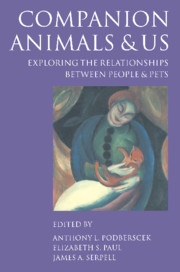Book contents
9 - Personality research on pets and their owners: conceptual issues and review
from Part II - The nature of the relationship
Summary
INTRODUCTION
Personality research on companion animals and their owners has grown steadily over the past few decades. A major focus, inspired by reports on the health benefits of pet ownership (see Friedmann, Thomas & Eddy, Chapter 8), has been on whether the personality traits of pet owners are different to those of non-owners. In addition, there has been a rapid rise in interest in how owners’ personalities may influence companion animal behaviour and behaviour problems. More recently, attention has turned to the structure of personality in companion animals and whether it is similar to that of humans.
All these areas are important to furthering our understanding of the human–pet relationship but, to date, no common currency of scientific findings has been produced. This chapter aims to bring the research together for the first time, to evaluate it and suggest ways forward for future study. In addition, we will highlight a number of conceptual issues. To this end, we have divided the chapter into three major parts reflecting three questions: (a) how can we make cross-species comparisons of personality? (b) can human personality influence companion animal personality? and (c) what can we determine about the personalities of pet owners? For the purposes of this review, we define personality traits as enduring, relatively stable, characteristics used to explain and describe an individual's behaviour across time and situations (John & Gosling, 2000).
HOW CAN WE MAKE CROSS-SPECIES COMPARISONS OF PERSONALITY?
It is important to clarify at the outset that personality comparisons are more typically made within species (e.g. between two dogs) rather than across species (e.g. between a dog and a cat). Later, we will address issues that may arise from confusing these two types of comparison. Nevertheless, it is worth bearing in mind that although cross-species comparisons of personality are sensible, they are rather rare because most uses of personality are limited to the human domain.
There are two levels at which personality comparisons can be made across species. The first level focuses on the structure underlying personality; for example, are the main personality dimensions associated with horses the same dimensions as those associated with ferrets? The second level focuses on cross-species comparisons of personality traits or dimensions; for example, are rabbits bolder than hedgehogs? In the next two sections we will discuss conceptual issues and empirical research associated with both levels of comparison.
- Type
- Chapter
- Information
- Companion Animals and UsExploring the relationships between people and pets, pp. 143 - 167Publisher: Cambridge University PressPrint publication year: 2000

